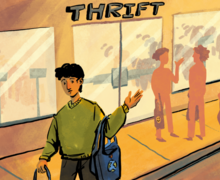Kramer: McDonald’s needs to revise business plan to combat falling sales
The rise of fast-casual restaurants, like Chipotle Mexican Grill, are proving to be a challenge for the golden-arch mainstay of American food culture. Old Ronald McDonald should hit the reset button on his business plan before it gets wrapped up in a flour tortilla avalanche of hot sauce and extra black beans.
According to an Oct. 21 article by Slate, profits for McDonald’s have dropped 30 percent in a year. Sales from restaurants open for more than a year have dropped more than 3 percent. McDonald’s is down 8 percent on the Stock Exchange over eight months.
CEO Don Thompson was at a loss. In a statement, he simply referred to it as a “significant decline.” He was acting like a hapless parental figure upset with his child.
Fast-casual restaurants on the other hand — think Panera Bread, Five Guys or Chipotle — allow for cheaper prices than full service places like TGI Fridays, but generally better quality food than what McDonald’s or Taco Bell can dish out. It’s fast enough to grab on a whim, but good enough quality that you aren’t embarrassed to tell anyone what you ate for lunch.
Chipotle is a leading fast casual restaurant and has seen a sparkling six-fold stock increase since 2010, up to over 600 dollars per share from 100. McDonald’s has been heading the opposite direction, with same store sales in August seeing their greatest decline since 2003, according to an Aug. 23 report from The Wall Street Journal.
The key to McDonald’s’ failure and fast-casual’s success has been the marketer’s buzz word: the millennial. Open any company’s marketing plan from the past decade and you’re sure to find them referencing us, the 19–21 year old college students and young adults. According to The Wall Street Journal report, the percentage of that demographic who visit McDonald’s each month has dropped by almost 13 percent since 2011.
McDonald’s has some decisions to make now as far as how it wants to pursue a turnaround. Thompson said that his new plan of action is to simplify the menu and emphasize “favorite dishes,” according to a report by Restaurant News, an industry website.
Will that be enough to bring back hungry eaters? Perhaps Thompson is too afraid to admit that there’s been a change of tastes entirely. The model of Chipotle is the ability to chose your own ingredients, ones that are, at least perceptively, healthier and more natural. McDonald’s has been in front of a nationwide courtroom for decades regarding the skepticism over its ingredients and dubious marketing plans.
This may be a bigger problem than new commercials and menus can solve. Relentless ad campaigns hoisting the “I’m Lovin’ It” slogan are proving outdated. McDonald’s needs a full reform of its business plan in order to regain what it has lost and what it is about to lose. It needs to show that it offers more than just cheap burgers, especially if consumers are showing that they’re willing to spend more on a Chipotle burrito.
Thomson’s new plan for “simplification” may soften the losses, but there will be more doom to come if it proves that McDonald’s is going out of style entirely. He should move quickly to re-attract younger buyers and admit the mistake of a massive menu. If that ignites a resurrection of sales, good for McDonald’s. If it doesn’t, it truly has a problem of taste and preference on its hands.
Phil Kramer is a sophomore finance major. His column appears weekly. He can be reached at pwkramer@syr.edu.
Published on October 27, 2014 at 12:01 am





